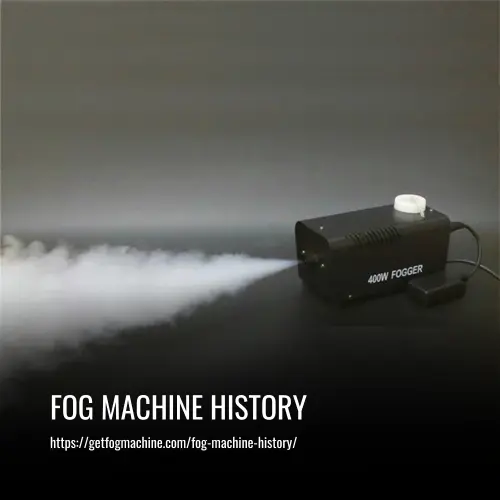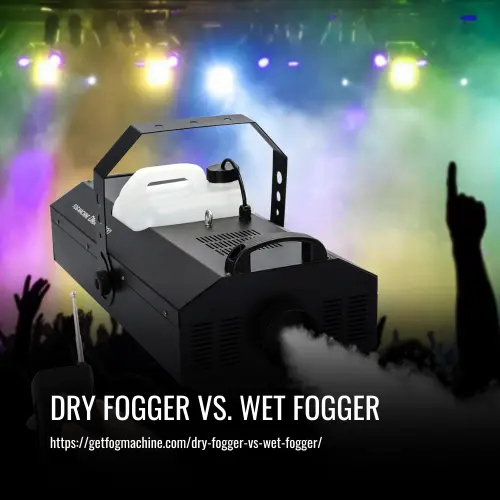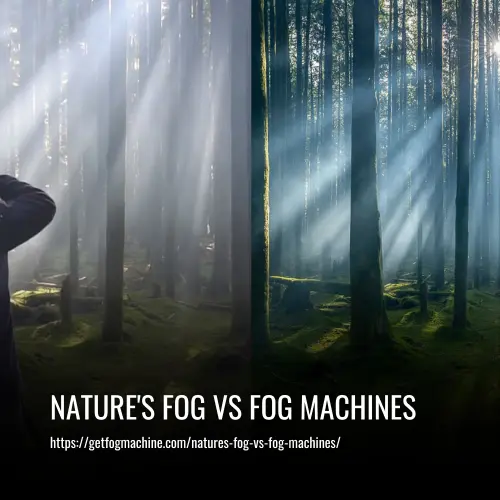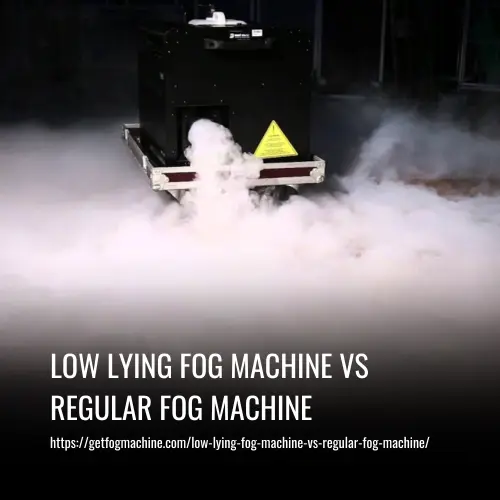Fog Machine History
This post contains affiliate links. As an Amazon Associate, we earn from qualifying purchases.
Fog and steam effects have been widely used in theatre productions for centuries, often produced by boiling water or pyrotechnics. Until the 1970s, paraffin or oil vapor was the common method to create these effects. The lack of precise control and the flammable nature of these materials posed safety risks.
In the 1970s, Günther Schaidt developed the modern fog machine, revolutionizing the industry. This invention allowed for safer, easier, and more precise control of smoke and steam effects on theatre and other stages.

Early Theatrical Origins of Fog Machine
Theatrical productions in ancient times lacked the advanced equipment used in modern times to create captivating effects on stage. Instead, ancient techniques of Greek origins were used to create atmospheric stage effects that would evolve over time.
1. Roman Innovations
The concept of atmospheric effects was further developed during the Roman era which saw the implementation of new elements, including hydraulic systems. These systems enabled the creation of waves or even flooding of the stage for dramatic scenes.
2. Renaissance Fogs
During the Renaissance period, the fog was frequently used in plays and performances to set a mysterious tone or represent otherworldly locales. Various materials were burned including wet straw or damp wood with fragrant leaves in order to produce thick smoke with a distinctive aroma.
3. Baroque Spectacles
The Baroque era brought about more elaborate spectacles that further explored the use of foggy atmospheres combined with intricate sets and costumes to transport audiences into fantastical realms.
4. The Evolution of Theatrical Effects
Throughout history, theater has continued to evolve, and so have methods of creating unforgettable experiences on stage. The journey from Greek origins and Roman innovations to Renaissance fogs and Baroque spectacles has contributed something unique and valuable to the production of memorable theatrical experiences that captivate audiences worldwide.
Breakthrough Innovations in Fog Production
The history of fog machines can be traced back to early theatrical productions where practical effects like clouds of fog were created using heated water. However, the evolution of fog machines has been marked by significant advancements that have transformed the way we produce atmospheric effects.
1. Chemical Formulations
Early fog machines relied on heavy mineral oils or glycol-based solutions, which could be harmful when inhaled. This led to the development of safer and healthier alternatives. Modern fog fluids have evolved to incorporate food-grade ingredients, making them safer while still producing remarkable atmospheric effects.
2. Iconic Performances
Fog machines have played a significant role in iconic performances that pushed the boundaries of what is possible with fog technology. From classic rock concerts like Pink Floyd’s legendary laser-filled shows to groundbreaking theatrical productions like Andrew Lloyd Webber’s ‘Phantom of the Opera’, these awe-inspiring performances showcased the capabilities of fog machines.
3. Safety Improvements
As our understanding of health risks associated with certain chemicals grew, efforts were made to ensure the safety of both performers and audience members. This led to the development of safety features like better ventilation systems, automatic shut-off mechanisms when fluid levels run low, and temperature controls for preventing burns from overheated devices.
4. Eco-Friendly Alternatives
Manufacturers have developed greener options for fog production in response to a growing focus on sustainability within the entertainment industry. Biodegradable fluids made from renewable resources and energy-efficient machines that consume less power during operation have been introduced as eco-friendly alternatives.
Advancements in Fog Machine Technology
Fog machines have undergone significant changes since their inception in early theater productions. As technology continues to advance, new innovations are revolutionizing fog production, enhancing the way we experience atmospheric effects in live performances.
1. Portable Foggers
Portable foggers have become increasingly popular for their versatility in creating dynamic visual effects on the go. These compact devices allow event organizers, performers, and enthusiasts to bring theatrics with them to any location, making it easier to add ambiance to any outdoor or indoor space.
2. Eco-Friendly Solutions
Sustainability is an essential factor in the entertainment industry, and as more individuals prioritize sustainable practices, eco-friendly fog solutions are gaining traction. Water-based fog fluids, for instance, provide impressive visual displays while minimizing the environmental impact.
3. Fog Fluid Varieties
The variety of fog fluid options available today has expanded to meet the diverse needs of users. Low-lying fog fluids are perfect for creepy graveyard scenes, while high-density bursts are ideal for a stunning concert backdrop. This range allows for greater creativity and customization when designing atmospheric effects for various events and venues.
4. Digital Control Systems
Digital control systems have revolutionized fog machine technology by enabling precise control over output levels, timing, and synchronizing multiple machines together. The level of accuracy and precision ensures seamless integration into live performances without detracting from the overall experience.
5. Customizable Fog Effects
The customizable options available with modern fog machines can transform ordinary events into immersive and captivating experiences. With all the innovative features available today, it’s never been easier or more exciting to experiment with new ways to elevate your productions through atmospheric enhancements and create unforgettable moments in live events.
Modern Applications and Uses of Fog Machines
Fog machines have come a long way from their origins as simple heating water devices. These days, they are used in a variety of industries, from entertainment to air quality control and even military tactics.
1. Entertainment Industry
Fog machines are a staple in the entertainment industry, particularly in creating special effects for stage productions, concerts, or festivals. They are often used in conjunction with laser lights or other atmospheric effects to create a truly immersive experience.
2. Safety Preparedness
Fog machines also play a crucial role in safety preparedness by simulating various scenarios where visibility is limited due to smoke or haze. This allows first responders or military personnel to practice their tactics under such conditions, preparing them for real-life emergencies.
3. Air Quality Control
Another noteworthy application of fog machines is in air purification systems. By producing fine mist that can effectively trap particulate matter and contaminants present in the air, these devices help improve indoor air quality significantly. This feature makes them especially useful for spaces like museums, galleries, or laboratories, where maintaining pristine air quality is essential.
4. Military Tactics
Fog machines have also found a place in military tactics. They serve as effective means of creating concealment during operations or training exercises by generating large volumes of dense fog quickly. This helps to obstruct enemy vision and provides cover for troops on the move while confusing adversaries’ tracking systems.
Future Developments and Trends
Fog machines have come a long way since their initial development decades ago. As technology continues to evolve, so do the possibilities of what they can offer. Here are some of the likely future developments and trends for fog machines.
1. Eco-friendly Solutions
There’s a growing need for eco-friendly solutions in every industry, and the fog machine sector is no exception. As a result, we can expect to see more energy-efficient devices, lower fog fluid consumption, and an exploration of alternative, environmentally friendly fluids for generating fog. This approach will help reduce the carbon footprint and minimize the harm to both the environment and people.
2. Customizable Fog Options
In the future, customizable fog options may emerge with adjustable density and color for diverse applications like entertainment events, immersive experiences, theme parks, or emergency training scenarios. This feature will allow users to fine-tune their fog machine settings based on the unique requirements of their events.
3. IoT Integration
IoT (Internet of Things) integration could add new dimensions for future fog machine design. With more devices connected and controllable through networks or smartphones, future fog machines may have capabilities beyond just producing haze. For instance, it could be integrated with other smart devices to create synchronized effects during a live show or remotely controlled according to user preferences on a mobile app.
4. Portability
Portability will become increasingly important in the future as users demand smaller form factors for easy transportation and deployment at various events. New and improved versions of fog machines may have features such as foldable arms or retractable handles for easy carrying, while still producing powerful fog effects.
5. Enhanced Safety Features
Overheating, potential fire hazards, and health issues due to prolonged exposure to certain types of chemicals in fog fluid are relevant concerns in the current use of fog machines. Manufacturers are continually seeking ways to eradicate these issues. Future designs may incorporate advanced sensors capable of detecting overheating or other malfunctions before they escalate into a serious problems. Further research into safer alternatives for chemical components could also lead to innovations within this field.
FAQs
Fog machines were first developed in the late 1950s by a man named Harold “Doc” Edgerton, a professor at the Massachusetts Institute of Technology (MIT). He initially invented the machine to enhance photography by creating a thick, consistent fog to capture high-speed events more clearly.
From Doc Edgerton’s early designs, fog machines underwent significant advancements in technology. In the 1970s, they transitioned from using dry ice to heat exchangers and glycol-based systems. Over time, improvements were made in terms of efficiency, size, and controllability, resulting in the modern, versatile fog machines we see today.
Fog machines found their way into the entertainment industry in the early 1980s. They were initially used in theatrical performances and later became a staple in concerts, nightclubs, and other live events to create atmospheric effects, enhance lighting, and add drama to performances.
Fog machines have been used extensively in the film industry to create various atmospheric effects. They help add ambiance, simulate environmental conditions, and enhance the visual impact of scenes. The fog generated by these machines has been crucial in producing dramatic effects in horror, science fiction, and fantasy genres.
Technological advancements have led to more efficient and user-friendly fog machines. Modern machines offer better control over fog density, duration, and dispersion. Additionally, developments in eco-friendly fluids have reduced environmental impact while maintaining performance standards.
While generally safe when used correctly, fog machines emit a dense fog that may reduce visibility. Proper ventilation is crucial to prevent the accumulation of fog, which could pose health risks or trigger fire alarms in enclosed spaces. Additionally, using appropriate fluids and following manufacturer guidelines for operation helps ensure safety.
Conclusion
In conclusion, this article has shed light on the intriguing history of fog machines. We have seen how these machines have evolved over time, from using heating water to creating water vapor to the use of solid carbon dioxide.
We have also discussed the various industrial and entertainment applications of fog machines, ranging from theme parks to stage productions. Despite their widespread use, it is important to note potential health effects such as skin or respiratory irritation.
Overall, this article serves as a comprehensive guide to the history of fog machines and the technology behind them. Whether you are an aspiring special effects artist or simply curious about the science behind atmospheric effects, this article has something to offer.






